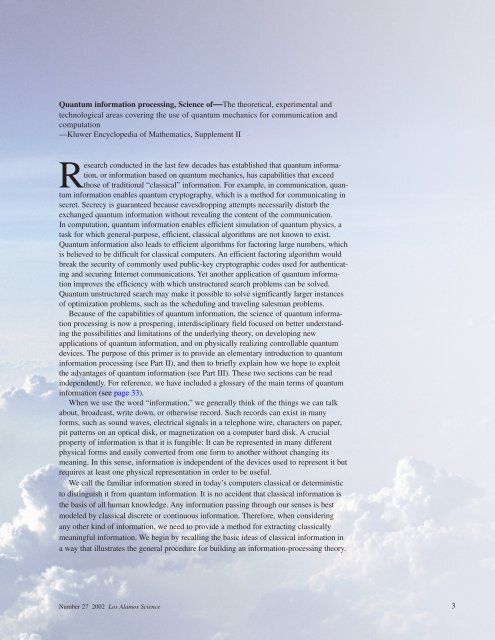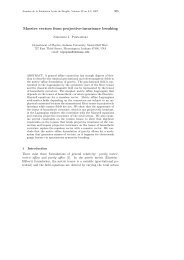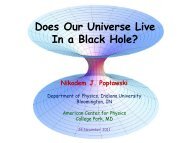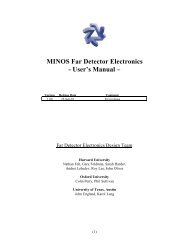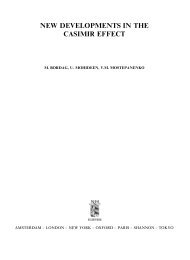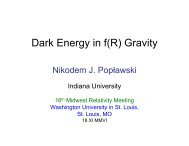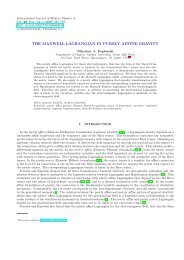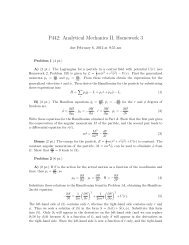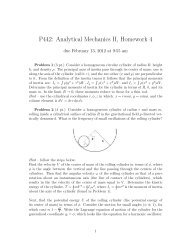Quantum Information Processing
Quantum Information Processing
Quantum Information Processing
Create successful ePaper yourself
Turn your PDF publications into a flip-book with our unique Google optimized e-Paper software.
<strong>Quantum</strong> information processing, Science of—The theoretical, experimental and<br />
technological areas covering the use of quantum mechanics for communication and<br />
computation<br />
—Kluwer Encyclopedia of Mathematics, Supplement II<br />
Research conducted in the last few decades has established that quantum information,<br />
or information based on quantum mechanics, has capabilities that exceed<br />
those of traditional “classical” information. For example, in communication, quantum<br />
information enables quantum cryptography, which is a method for communicating in<br />
secret. Secrecy is guaranteed because eavesdropping attempts necessarily disturb the<br />
exchanged quantum information without revealing the content of the communication.<br />
In computation, quantum information enables efficient simulation of quantum physics, a<br />
task for which general-purpose, efficient, classical algorithms are not known to exist.<br />
<strong>Quantum</strong> information also leads to efficient algorithms for factoring large numbers, which<br />
is believed to be difficult for classical computers. An efficient factoring algorithm would<br />
break the security of commonly used public-key cryptographic codes used for authenticating<br />
and securing Internet communications. Yet another application of quantum information<br />
improves the efficiency with which unstructured search problems can be solved.<br />
<strong>Quantum</strong> unstructured search may make it possible to solve significantly larger instances<br />
of optimization problems, such as the scheduling and traveling salesman problems.<br />
Because of the capabilities of quantum information, the science of quantum information<br />
processing is now a prospering, interdisciplinary field focused on better understanding<br />
the possibilities and limitations of the underlying theory, on developing new<br />
applications of quantum information, and on physically realizing controllable quantum<br />
devices. The purpose of this primer is to provide an elementary introduction to quantum<br />
information processing (see Part II), and then to briefly explain how we hope to exploit<br />
the advantages of quantum information (see Part III). These two sections can be read<br />
independently. For reference, we have included a glossary of the main terms of quantum<br />
information (see page 33).<br />
When we use the word “information,” we generally think of the things we can talk<br />
about, broadcast, write down, or otherwise record. Such records can exist in many<br />
forms, such as sound waves, electrical signals in a telephone wire, characters on paper,<br />
pit patterns on an optical disk, or magnetization on a computer hard disk. A crucial<br />
property of information is that it is fungible: It can be represented in many different<br />
physical forms and easily converted from one form to another without changing its<br />
meaning. In this sense, information is independent of the devices used to represent it but<br />
requires at least one physical representation in order to be useful.<br />
We call the familiar information stored in today’s computers classical or deterministic<br />
to distinguish it from quantum information. It is no accident that classical information is<br />
the basis of all human knowledge. Any information passing through our senses is best<br />
modeled by classical discrete or continuous information. Therefore, when considering<br />
any other kind of information, we need to provide a method for extracting classically<br />
meaningful information. We begin by recalling the basic ideas of classical information in<br />
a way that illustrates the general procedure for building an information-processing theory.<br />
Number 27 2002 Los Alamos Science 3


